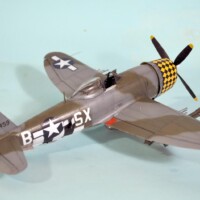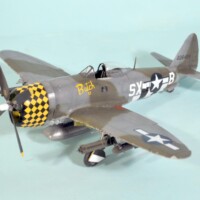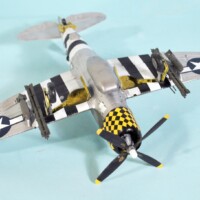Review: MiniArt 1/48 P-47D-25RE Thunderbolt
The Airplane:
The P-47D-25RE Thunderbolt went into production in the spring of 1944, following experimentation with a new full-vision “bubble” canopy in 1943 with the YP-47K, following Hawker's development of such a canopy for the Typhoon. It began appearing in England in May 1944, where it gained the nickname “Super-Bolt.”
Lt. Colonel William B. “Bill” Bailey:
Bill Bailey joined the Air Corps in 1940, and won his wings in 1941. In the fall of 1942, after promotion to 1st Lieutenant, he was among the 25 officers who were initially assigned to the 353rd Fighter Group when it was formed in September 1942. He was made squadron commander of the 352nd Fighter Squadron. Following training on the P-47B Thunderbolt over the winter of 1942-43, the 353rd was assigned to VIII Fighter Command. Arriving in England in late May 1943, they finally received new aircraft in early July when early-production P-47D Thunderbolts began arriving in England and were declared ready for operations on August 2, 1943, flying their first mission as a group on August 7. B
The 353rd was the first VIII Fighter Command group to fly a ground attack mission against Luftwaffe airfields in February 1944, when group commander Lt. Colonel Glenn Duncan led a strafing mission with 16 P-47s from all three squadrons against Gilze-Rijn airfield in Holland on February 24, 1944. In March, Duncan formed “Bill's Buzz Boys,” an inter-group formation of a flight each from the 353rd, 355th, 356th, and 361st Fighter Groups, with the intention of developing and testing ground attack strategies to be used by VIII Fighter Command now that the Luftwaffe was no longer opposing bombing attacks following the enormous losses of veteran pilots in Big Week and the three Berlin missions of March 6,8,9, 1944.
Bill Bailey was by this time the senior squadron commander in the group, with the 350th and 351st squadrons having both lost their original commanders in combat, and he took a leading role in working on the project. “Bill's Buzz Boys” were disbanded in mid-April, having field tested ground attack strategies. Between then and D-Day, the 353rd became the leading ground attack group in VIII Fighter Command. Bailey, having completed his tour at the end of April, took a 30 day leave before returning on a second tour just before D-Day, at which time he was promoted to Lt. Colonel.
The group was heavily committed to the Battle of Normandy following the invasion, along with the other P-47-equipped VIII Fighter Command groups. On July 7, 1944, group commander Glenn Duncan was shot down on a ground attack mission in western Germany. That afternoon, he was replaced as group commander by Lt. Colonel Ben Rimerman, the Group XO Flying, and Bill Bailey left the 352nd squadron to become Deputy Group Commander Flying, a position he held until October 1945 when the group was deactivated for return to the United States and disbandment.
The Kit:
The MiniArt P-47D-25RE was announced this past Spring and began drawing interest when CAD drawings were released that showed they intended a kit far more detailed than the Tamiya P-47s. There are two kits that have now been released, the “Basic Kit” that is reviewed here, and an “advanced” kit that includes a fully-detailed engine and accessories section and full gunbays and ammo compartments in the wings. The kit has petite surface detail similar in quality to the Eduard P-51D series of kits. Decals are provided for the P-47D-25re flown by Lt. Colonel Dave Schilling in the 56th Fighter Group and a P-47D-25RE of the 78th Fighter Group's 84th Squadron, both from the period following D-Day in the summer of 1944.
The decals are the only place where the kit “falls down” since MiniArt - like many others - didn't get the memo on the size and geometry of US National Insignia. Also, the checkerboard decal for the 78th FG airplane is incorrect, with checkered squares overlapping the panels of the cowling (78th FG P-47s had their checkers applied with the cowling removed from the airplane). Fortunately, the plethora of P-47D decals that have been created over the past 30+ years can be found at eBay dealers, should a modeler not have their own stash.
Construction:
Like all other modern kits designed with CAD, parts fit is very precise, and a modeler must be certain all mating surfaces are “as clean as a hound's tooth” to avoid cascading fit problems in construction. The kit is detailed with lots more pieces than the Tamiya kit has, and a modeler is well-advised to take the revolutionary act of reading and following the instructions; they are not “somebody's opinion.”
Construction starts with the cockpit, which is much more detailed than the Tamiya kit. I painted the main parts with Tamiya Dark Green (RLM-70) a good replacement for Dull Dark Green, then painted all the other small parts before assembling them. I departed from a fully OOB build by using Eduard seatbelts. Once the cockpit was assembled, I installed it in the right fuselage half and proceeded to assemble the other detail parts for the fuselage, then glued the two halves together. Fit is so tight that all I had to do to lose the centerline seam was a light scrapedown, followed by rescribing rivet detail across the seam with my pounce wheel.
The gear well in each wing is made up of individual pieces. I painted these Yellow Zinc Chromate. Unlike the Tamiya kit, the gun barrel assembly is attached at this point before further assembly. Several of the World's Finest Psychic Kit Reviewers over at The World's Most Wonderful Modeling Site, who are able to suss out all the failings of a new kit without ever having to open an actual kit and assemble it, have declared these gun barrels are unacceptable because they are not “horizontal to the ground” in the wing as they should be; however, when I finished the assembly of the wings, the gun barrels were magically in the proper position.
All the control surfaces are separate, and the flaps cannot be dropped; this is actually the proper way they should be. Several pilots in the 78th group who I interviewed for my books told me that the fine for not raising flaps immediately after touchdown was 10 Pounds - $70 out of a 2nd Lieutenant's pay at the time of $250; as one said, “you only forgot once.”
The wings do not have carry-through spars like the Tamiya kit, but the extended spar on each side will help align them properly and the part design won't allow a close fit without the wing being properly aligned. If you are going to have the underwing pylon and the rocket tubes, be sure to open the alignment holes before gluing the wing halves together.
The R-2800 engine in the kit is the best I have seen as an injection-molded plastic part. There is more detail in the engine and the assembly of the cowling than in any earlier kit. For this kit, one only uses the two piston rows and the front parts of the engine, leaving the very complete exhaust system on the sprue since that is for the “advanced” kit. I had no problem assembling the engine cowling accurately, following the kit instructions as to the sequence of attachment.
Painting:
I had decided to do Lt. Colonel Bill Bailey's P-47D-25RE, “Butch II,” from the Aeromaster sheet 48163 “Best Seller Thunderbolts” which has the cowling diamonds fitted for the Tamiya kit (which means they fit this kit).
I painted the cowling yellow and masked that off, then painted the white D-Day stripes and masked them off. I then painted the lower surfaces overall with Tamiy Semi-Gloss Black as primer for the Vgallejo Aluminum, and pre-shaded the upper surfaces along panel lines. I masked off the D-Day stripes completely, then painted the NMF lower surfaces, using Vallejo “Aluminum.” the upper surface camouflage was done with Tamiya RAF colors Ocean Grey and Dark Green, applied freehand and referencing the painting diagram and the photo of “Butch II” I found on the Internet.
Decals:
I had some separation on one part of the diamond decals, which necessitated using part of the decal from another Aeromaster sheet and fitting the two to overlap correctly. Referencing the photo, I filled in the yellow area immediately around the front of the cowling with Tamiya Flat Black. The rest of the decals went on without problem after I left them to soak to the point where they started to slide off the backing, and they went down without problem under a coat of Solvaset. I used Fundekals National Insignia for the underwing markings.
Final Assembly:
MiniArt provides every kind of bomb used by the Thunderbolt and the most detail-accurate rocket tubes of any kit. I armed this with the rocket tubes the group began using in mid-June 1944, and two 500-lb bombs.
I then attached the landing gear and the prop and unmasked the canopy and attached it in the open position.
Overall Assessment:
This is the best kit available of the bubbletop P-47 in 1/48 scale. It outdoes the Tamiya Thunderbolt the way the Eduard P-51D outdoes the Tamiya Mustang. That doesn't make the Tamiya kits obsolete, but if you are a serious P-47 fan, this is the better kit. It is only $5 more expensive in MSRP than the contemporary MSRP for the Tamiya kit, and there are bargains to be found on the internet. I am already planning what markings I will use on the next one (Thundercals decals to do “No Guts No Glory”).
Recommended for any modeler willing to follow the instructions to get an excellent model.
Review kit courtesy of you book buyers.
















Excellent build. Great write up.
A perfect copy of Butch II, Tom @tcinla
Great work on the painting and the way you got that checkerboard pattern done on the cowling.
Nice to read article as well.
Excellent model of an excellent kit, Tom!
Loved "Bill" Bailey 's story!
Great write up and build
, Tom! Your craftsmanship makes me want to pickup the kit.
I know "Butch II" because it was the featured P-47D in one of the first Bill Gunston airplane encyclopedias I ever owned. I didn't know who the pilot was or his history.
The MiniArt kit looks like a gem, but I have a couple of the Tam bubbletop kits which means I don't HAVE to have this kit... yet.
Hey, when I went to a local show here back in early October, one of the dealers had Tamiya kits at cheapcheap prices without decals. So I picked up two Razorbacks, a P-47D and the only P-47M (lets you make all the bubbletops) for $14 each. They will be built. Like I say in my reviews, the Tamiya P-47s are like a great Nathan's hot dog with sauerkraut and the works, a bag of classic Fritos and a Mexican Coca-Cola (still uses cane sugar and not corn syrup like US Coke does). You know exactly what you're getting and you know you're going to like it.
Well, he is beautiful. You really did well.
Well done, Tom. Thanks for the review.
This looks really good Tom. I like the camo paint the 56th used. I also just realized I’m now two generations behind in P-47s. All of my built Jugs are Monogram. It might be time to build one of the two Tamiya’s in the stash and then get one of these.
John Healy (@j-healy)
I'm right there in the same boat with you...Monogram only so far for me too. So maybe it's time to break out a few P-47's from our stashes for us ?
Soon, Louis! I’m finally starting my FM-2 after finishing a few 1/72 projects. I should really do the Tamiya P-47 Razorback soon. I was the late Norris Graser’s first customer for his last project, the Burma Banshee set. I bought it from him along with a few of his resin drop tanks at the Crystal Lake show on a visit up in Illinois last year. BTW, thanks to you and Tom for blazing the FM-2 trail! It’s a nice kit. Here’s a pic with a hint where mine is headed.
1 attached image. Click to enlarge.
Looks like a nice destination, @j-healy.
@lgardner - do a Tamiya P-47. It's like a great Nathan's hot dog with sauerkraut and the works, a bag of Fritos and a Mexican coke (cane sugar, no corn syrup). You know exactly what you're getting and you know you're going to like it. That'll get your feet wet for a MiniArt P-47.
I always enjoy reading your kit reviews. I now know which kit to buy to expand my P-47 collection. Now to reposition those flaps on my Tamiya Razorback…
I wonder, "Several of the World's Finest Psychic Kit Reviewers over at The World's Most Wonderful Modeling Site"..Well said.
Looks fabulous- will definitely be adding this kit to my wish list. Great job!
Another great build and review, Tom. I haven't built a P-47 in years...the last was the old Monogram kit. This sounds like the one I need to do. Thanks.
Good looking build Tom. I may have to pick one of these up.
Great build and review, Tom! Happy to have contributed recently to your "review stash cash!"
Thank you!
Looks like a real winner. Some of these new guys in the game will keep my credit card company happy for awhile!
That kit looks even better than the ex-Hawk Testors 1/48 '47D! 😄
Great article, Tom @tcinla, and a lovely Thunderbolt! 👍
Great article Mr. Cleaver, and a beautiful build, This kit looks amazing. I think flaps up was the SOP for most aircraft operating during the war, definitely less chance of damage that way. I think for modelers it comes down to a choice of accuracy vs. looking cool. I have to admit I sometimes go for looking cool, mostly because I like the mechanics for it all.
I appreciate your no nonsense reviews of the kits you do, and your builds are always outstanding.
Tom Cleaver (@tcinla)
Looks like you did a great job on the P-47. Yeah, my wallet is going to take a beating... again. 🙂 After reading some of these comments, I have realized that I too have yet to build a Tamiya P-47. I have only built the Monogram kits in 1/48. I just got an email message from Fundekals that they are releasing a new set of Thunderbolt decals very soon...
and they got a P-47D for a complete restoration in now at the shop... so I can definitely see a few P-47's rolling off the work bench soon.
I enjoyed reading your article, as I always do. Thanks for posting this.
Have a Merry Christmas buddy.
A Happy Merry to you too.
That looks like the P-47D that was in Joe Laughlin's markings as "5 x 5".
An MiniArt just announced kit number 480023 - a P-47D-30RE (that's the same model as what is being restored in your photos). As someone else said, I wonder what kits 480004-22 are going to be?
Tom Cleaver (@tcinla)
You are correct. This is the very same plane. The Collings Foundation traded their Tuskegee PT-17 for this one. It's scheduled for a full on restoration, and the plans are to fly her out of the shop.
The comment about what their next Mini Art kits will be made me smile... Thanks.
An excellent model and really great work with the decals.
Very nice.
After building the minimart bulldozer I need to let the PTSD wear off before I venture down that road again. Sounds like this Jug is much better plastic